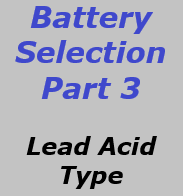
This segment will be limited to the standard flat plate, including tubular, and will not cover the modern variants of TPPL, Gel Cell, etc.
The different ways that manufacturers go to market are more easily highlighted by the way they meet the special needs and circumstances of the users. One of the more common special needs is cold temperature applications such as food suppliers. In these applications, one supplier will use a flat plate with a higher acid content, and the other will offer a tubular battery, which operates the same as a flat plate but has more activity area due to its plate design: typically taking a 125AH plate to about 140AH nominally. Others will add an extra plate to the battery, and possibly more acid, giving it more operating capacity to compensate for lag caused by the time in the freezers or coolers.
The same methods are used for some high-use applications but are often avoided by charging configurations such as opportunity charging. Whatever the method used for each, the winner in this category is the one that sticks closest to its base design and relies on quality and consistency in care to get the job done for the expected lifespan of the battery, which usually runs closely with warranty and lease terms. In other words, the fewer variations of the basic battery there are, the higher the probability of consistent service the line of batteries will provide across the board, and that sometimes means sacrificing the ability to operate in certain desired profiles and applications.
In most cases, a premium flat plate battery with a companion charger is the best bet.
Type of Charger
There was a time not so long ago when “smart chargers” did not exist, but the “not so smart” chargers do still exist, and they are great for some applications, but very few, given the benefits of the smart chargers, especially the good ones.
The not-so-smart chargers are the ferro-resonant chargers that are still around and are identified by their equalized/weekly buttons and low-tech appearance. The benefits to these early-generation chargers are that there are still a lot of techs who can fix them, but they last a really long time.
A downside to the older tech is that it charges, runs on full blast and goes full-on until it’s done or it gets unplugged. One of the big issues with the pre-smart charger charges is hot charging, and that is when the battery gets plugged in throughout the day, then the charger will gas the battery several times a day and cause a shorter battery life while embedding a need for hot charging.
Something else that is difficult to master with Ferro chargers is the habit of weekly charges, which should be done every week to prevent the sulfation of the battery.
Many smart chargers on the other hand will equalize automatically at a pre-set time as long as the battery is plugged in when it is time. One of the things I believe that causes the most confusion is the opportunity charge feature that may or not be installed on a smart charger. This feature gives the charger the ability to stop charging when the battery reaches 80% charge outside of full charge times. Chargers are typically sold as conventional chargers unless otherwise specified during the selling process. The opportunity chargers will usually charge to with higher charge power to complete the charging process faster. In some cases, the supplier will refrain from offering or configuring the project without a reason to, and that is a good thing. It is often thought that using an opportunity charger will keep the battery from the side effects of hot charging. The truth is that it may to some effect, but it won’t offset the cause of hot charging which is actually inconstant watering and weekly charging. The latter can be avoided with a smart charger, and the former with watering posts equalize every or every other week.
Letting a professional decide which charge profile you need is wise, but if were picking a charger brand, I would go with a modular smart charger that is partnered with a high-quality battery. There are chargers on the market with the ability to up and downscale power and voltage and have lights that can be seen from across the facility to indicate charging status.
The high-quality smart charger, or “high frequency” charger is hard to beat when it comes to efficiency and the life of the battery. However, if it’s a normal use of 1 or two forklifts, then a good Ferro Magnetic charger will suffice if the budget requires it.
By Dustin Link






